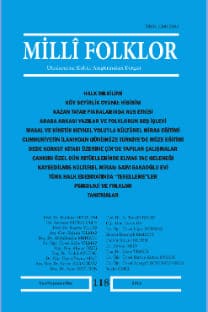Osmanlı sarayında aşure geleneği uygulamasına dair
On the aşure tradition in ottoman palace
___
- Aça, Mehmet. “Kaynaklar”. Türk Halk Edebiyatı El Kitabı. Edit. Öcal Oğuz. Ankara: Grafiker Yay., 2010.
- Akbulut, Dilek. “Bektaşi Kazanlarından Saray Aşureliklerine Bir Paylaşım Geleneği Ola- rak Aşure”. Türk Kültürü ve Hacı Bektaşı Veli Araştırma Dergisi Sayı 55, 2010: 269- 280.
- Akyıldız, Ali. Mümin ve Müsrif Bir Padişah Kızı Refia Sultan. İstanbul: Tarih Vakfı Yurt Ya- yınları, 2003a. ——. “Mâbeyn-i Hümâyûn”, DİA, C. 27, TDV Ya- yını, (2003b): 283-286. And, Metin. Ritüelden Drama- Kerbela-Muhar- rem-Taziye. I. Baskı, İstanbul: YKY, 2002.
- Arslan, Mehmet-Mehtap Erdoğan. Kerbela Mer- siyeleri. (Tunceli Üniversitesi 2008), Anka- ra: Grafiker Yayınları, 2009.
- Beşirli, Hayati. “Yemek, Kültür ve Kimlik”. Millî Folklor 87 (2010):159-169.
- ——. “Türk Devlet Sisteminde Toplumsal Dü- zenin İnşasında İşlevselci Bakış Açısıyla “Ülüş” ve “Cilik” Geleneği”. Türk Kültü- rü ve Hacı Bektaş Velî Araştırma Dergisi 63(2012): 337-358.
- Bilgin, Arif. “Seçkin Mekânda Seçkin Damaklar: Osmanlı Sarayında Beslenme Alışkanlıkları (15.-17. Yüzyıl)”. Yemek Kitabı Tarih- Halk Bilimi- Edebiyat. haz. M. Sabri Koz. İstan- bul: Kitabevi Yayınları, (2003a): 78-118.
- ——. “Matbâh-ı âmire”. DİA. C. 28, Ankara: TDV Yayını, (2003b): 115-119. ——.
- Osmanlı Saray Mutfağı (1453-1650). 1. Baskı, İstanbul: Kitabevi Yayını, 2004. Bulduk, Sıdıka. “Üniversite Öğrencilerinin Gele- neksel Türk Tatlılarını Bilme Durumu Üzerine Bir Araştırma”. Türk Mutfak Kültürü Üzerine Araştırmalar, Editör Kamil Toygar, Ankara: Türk Halk Kültürünü Araştırma ve Tanıtma Vakfı Yayını, (1993), 22-26.
- Bulduk, Sıdıka-Suna Baykan. “Geleneksel Türk Tatlıları ve Diğer Ülke Tatlılarının Üniver- site Gençliğinde Tercih Sıralaması”. Düzen- leyen Feyzi Halıcı. Dördüncü Milletlerarası Yemek Kongresi. Konya Kültür ve Turizm Vakfı Yayını, (1993): 72-77.
- Cevdet Bahriye (C.BH),123/5989, Cevdet Dahiliye (C.DH.), 239/11920, Cevdet Saray (CSM),16/841, 22/1110, 79/4000, 95/4776, 147/7383, 148/7425, 150/7507, 158/7931, 161/8066, Çoruk, Ali Şükrü, Haz. Balıkhane Nazırı Ali Rıza Bey. Eski Zamanlarda İstanbul Hayatı. 2. Baskı, İstanbul: Kitabevi Yayını, 2001.
- Dundes, Alan. “Folklor Nedir?”. Çev. Gülay Ay- dın. Yay. Haz. Sezgin Karagül. Millî Folklor 65 (2005): 127-129.
- Ekici, Metin. Halk Bilgisi (Folklor) Derleme ve İnceleme Yöntemleri. Ankara: Geleneksel Yayıncılık, 2010. Eksen, İlhan. Çok Kültürlü İstanbul Mutfağı. Birinci Baskı, İstanbul: Sel Yayınları, 2001.
- Emecen, Feridun M. Taylesanizade Hafız Ab- dullah Efendi Tarihi İstanbul’un Uzun Dört Yılı (1785-1789). İstanbul: Tatav Yayınları, 2003.
- Ersoy, Ruhi. Sözlü Tarih Folklor İlişkisi Barak- lar Örneği Disiplinler Arası Bir Yaklaşım Denemesi. Ankara: Akçağ Yayını, 2009.
- Halıcı, Feyzi, Haz. Ali Eşref Dede’nin Yemek Ri- salesi. Ankara: Atatürk Kültür, Dil ve Tarih Yüksek Kurumu Atatürk Kültür Merkezi Yayınları, 1992. Haydaroğlu, İlknur. “Osmanlı Saray Mutfağın- dan Notlar”. A.Ü. DTCF, Tarih Araştırmala- rı Dergisi, 22/34, (2003): 1-9.
- Kılıç, A. Yavuz ve diğer. Bir Ağız Ekmek- Eski- şehir Geleneksel Yemek Kültürü. C. 2, Eski- şehir: Anadolu Üniversitesi Yayınları, 2003. Koçu, Reşad Ekrem. Topkapu Sarayı. İstanbul: yyy. Oğuz, Öcal. “Folklor: Ortak Bellek veya Payla- şılan Deneyim”. Millî Folklor 74, (2007):5-8.
- Osmanoğlu, Ayşe. Babam Abdülhamid. İstanbul: Güven Yayınevi, 1960. Özlü, Zeynel. “Osmanlı Devletinde Tekkelere Bir Bakış: Aşure Geleneği”. Türk Kültürü ve Hacı Bektaş Veli Araştırma Dergisi 57, (2011a): 191-212.
- ——.“Osmanlılarda Dondurma ve Dondurmacı- lık Mesleği İle İlgili Notlar”. Erdem Atatürk Kültür Merkezi Dergisi 59, Ankara, (2011b): 129-144.
- ——. “Osmanlı Saray Şekerleme ve Şekerleme- cileri İle İlgili Notlar,” Türk Kültürü ve Hacı Bektaş Veli Araştırma Dergisi 58, (2011c): 171-190. Pakalın, M. Zeki. “Âşûrâ Testisi”. Osmanlı Tarih Deyimleri ve Terimleri Sözlüğü. C. I, İstan- bul: MEB Yayını, (1971):101-102.
- Sadri Sema. Eski İstanbul Hatıraları. Haz. Ali Şükrü Çoruk. İstanbul: Kitabevi Yayınevi, 2008. Sakaoğlu, Necdet. “Aşure En Kutsal Yemek”. NTV Tarih Dergisi 12, (2010): 60-63.
- ——.“Âşûre”. Dünden Bugüne İslam Ansiklope- disi. C. 1, İstanbul: Kültür Bakanlığı ve Ta- rih Vakfı Ortak Yayını, (1993), 372-373. Sezer, Şennur ve Adnan Özyalçıner. Bir Zaman- ların İstanbulu. İstanbul: İnkılap Kitabevi, 2005.
- Şener, Adem. Aşura ve Muharrem Ayı. 1. Baskı, İstanbul: Sistem Matbaacılık, 2007. Top, Hüseyin H. Mevlevî Usul ve Adabı. İstanbul: Ötüken Yayınları, 2001.
- Ünsal, Artun. “Osmanlı Mutfağı”. Yemek Kitabı Tarih- Halk Bilimi- Edebiyat. Haz. M. Sab- ri Koz. İstanbul, Kitabevi Yayınları, (2003): 128-158.
- Wensınck, A. J. “Aşura”. İ.A.. C. I, İstanbul: Milli Eğitim Basımevi, (1950): 710-711.
- Yavuz, Yusuf Şevki. “Âşûrâ”. DİA. C. 4, İstanbul: TDV Yayını, (1991): 24-26.
- Yerasimos, Stefanos. Sultan Sofraları 15. ve 16. Yüzyılda Osmanlı Saray Mutfağı. İstanbul: YKY, 2002. Yerasimos, Marianna. Osmanlı Mutfağı. İstan- bul: Boyut Kitapları, 2002.
- Yıldız Tasnifi Perakende Evrakı Askeriye Ma- ruzatı (Y. PRK. ASK.), 29/50, 35/47, 50/48, 139/69, 227/48, Yıldız Tasnifi Perakende Evrakı Maarif Nezareti Maruzatı (Y. PRK. MF.), 1/36.
- Yücecan, Sevinç. “Âşûre”. Beşinci Milletlerarası Yemek Kongresi. Ankara: AKM Başkanlığı yayınları, (1999): 321-324.
- ISSN: 1300-3984
- Yayın Aralığı: 4
- Başlangıç: 1989
- Yayıncı: Geleneksel Yayıncılık Eğitim San. Tic. Ltd. Şti.
Saltuknâme’nin geçiş dönemleri açısından değerlendirilmesi
Uygur muhabbet koşaklarında sevgili veya kadın güzelliği
Folklorik imgelem bir toplumsal imgeler rezervuarı olarak imgelemin epistemolojik temellerine giriş
İdil tatarlarında destan geleneği ve yazılı destanlar
Düğün kavgalarının mitolojik kökenleri
Değişimin gölgesindeki gelenek: popüler diziler ve farklılaşan ad verme kültürü
Sözden çizgiye: karikatüristlerin gözünden sözlü anlatılar
Osmanlı imparatorluğunda telkîh-i cüderî (çiçek aşısı)*
Haldun EROĞLU, Güven DİNÇ, FATMA ŞİMŞEK
Halk hikâyelerinde bir imaj olarak bağ ve bahçenin kadın ve bedeni ile ilişkisi
